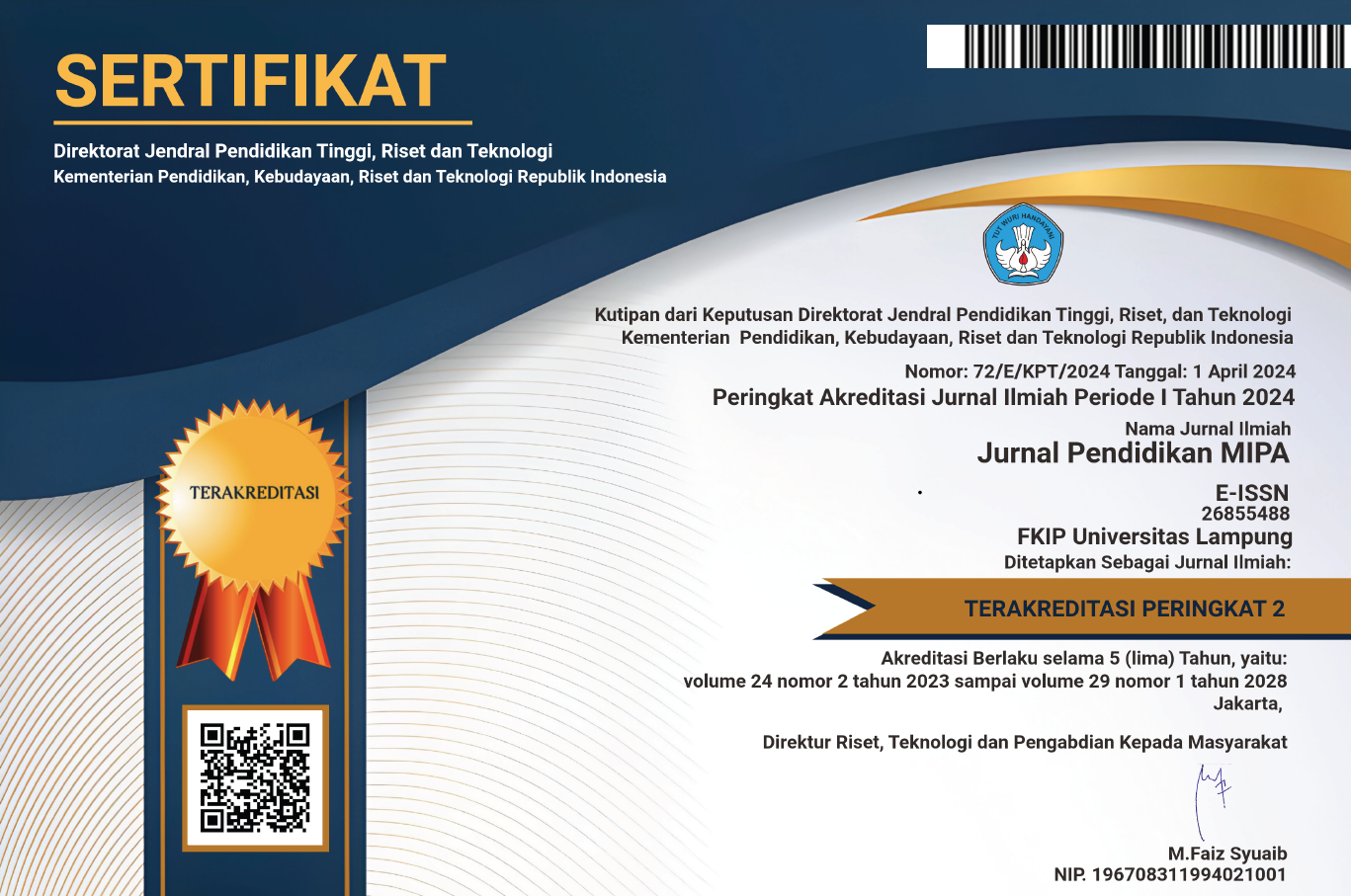Students’ Creative Thinking Skills on Green Chemistry by Designing Fire Reterdant Bamboo
 Country:
Country:
(1) University of Education Indonesia, Indonesia
(2) University of Education Indonesia, Indonesia
(3) University of Education Indonesia, Indonesia
This study aims to reveal students' creative thinking skills through the implementation of fire-retardant bamboo learning designs using ionic liquids that integrate chemical bonding materials and polymers. This research method is qualitative research. The research was conducted in class XII of SMA N Cibinong for two meetings with 36 students. The instruments used were observation sheets and video-audio recordings. The data obtained was analyzed using the transcript based lesson analysis method to determine the profile of students' creative thinking abilities. The creative thinking indicators used are five creative thinking indicators according to Munandar (1992). The percentage of indicators of creative thinking skills that appear the most in the first and second meetings is the indicator of fluency as much as 60.1% in the first meeting and as much as 62.1%. While the indicator with the least percentage of appearances at the first and second meetings is the originality indicator of 3.2% at the first meeting and as much as 0.1% at the second meeting learning activities.
Keywords: green chemistry, creative thinking skills, transcript base lesson analysis.
Anastas, P., & Eghbali, N. (2009). Green chemistry: principles and practice. Chemical Society Reviews, 39(1), 301–312.
Borowski, P. F. (2021). Significance and directions of energy development in african countries. Energies, 14(15).
Cheung, M. F. Y., & Wong, C. S. (2011). Transformational leadership, leader support, and employee creativity. Leadership & Organization Development Journal, 32(7), 656–672.
Cresswell, J. W. (2009). Research Design : Qualitative, quantitative, and mixed methods approaches. London : SAGE Publications.
Dayadi, I. (2021). Ketahanan api kayu sengon (paraserianthes falcataria (l.) nielsen) yang diawetkan dengan bahan pengawet boraks [fire resistance of sengon wood (paraserianthes falcataria (l.) nielsen) preserved with borax preservative]. Perennial, 17(1).
Flieger, J., & Flieger, M. (2020). Ionic liquids toxicity-benefits and threats. International Journal of Molecular Sciences, 21(17), 1–41.
Heinze, T. (2008). Interaksi cairan ionik dengan polisakarida – 2: selulosa. Wiley.
Javadian, A., Smith, I. F. C., & Hebel, D. E. (2020). Application of sustainable bamboo-based composite reinforcement in structural-concrete beams: Design and evaluation. Materials, 13(3), 1–26.
Liese, W., & Kohl, M. (2015). Bamboo the plant and its uses. In Medicinal Plants of South Asia: Novel Sources for Drug Discovery. Springer.
Marcus, Y. (2016). Ionic liquid properties. In Ionic liquid properties.
Margono. (2004). Metodologi penelitian pendidikan [educational research methodology]. Jakarta :Rineka Cipta.
Miyafuji, H. (2015). Application of ionic liquids for effective use of woody biomass. Journal of Wood Science, 61(4).
Miyafuji, H., & Fujiwara, Y. (2013). Fire resistance of wood treated with various ionic liquids (ILs). Holzforschung, 67(7), 787–793.
Nath, A. J. (2020). Bamboo: climate change adaptation and mitigation. In Angewandte Chemie International Edition, 6(11), 951–952.
Nulhakin, L., Fajar, S., & Asep, S. (2020). Improving students' creative thinking skills using problem-based learning (pbl) models assisted by interactive multimedia. JPPPF (Jurnal Penelitian dan Pengembangan Pendidikan Fisika).
Nurdiah. (2016). The potential of bamboo as building material in organic shaped buildings. Procedia - Social and Behavioral Sciences.
Prajapati, G., & (2022). A critical review of bamboo as a building material for sustainable development.
Salmeia, K. A. (2016). Recent advances for flame retardancy of textiles based on phosphorus chemistry. In Polymers, 8(9).
Shen, L., Yang, J., Zhang, R., Shao, C., & Song, X. (2019). The benefits and barriers for promoting bamboo as a green building material in China- An integrative analysis. Sustainability (Switzerland), 11(9).
Srikoon, S., Bunterm, T., Nethanomsak, T., & Tang, K. N. (2018). Effect of 5P model on academic achievement, creative thinking, and research characteristics. Kasetsart Journal of Social Sciences, 39(3), 488–495.
Sugiyanto, F. N., Masykuri, M., & Muzzazinah, M. (2018). Analysis of senior high school students’ creative thinking skills profile in Klaten regency. Journal of Physics: Conference Series, 1006(1).
Sugiyono. (2012). Metode penelitian kuantitatif, kualitatif, dan r&d [quantitative research methods, qualitative, and R&D]. Bandung: Alfabeta.
Supardi. (2015). Peran berpikir kreatif dalam proses pembelajaran matematika [The role of creative thinking in the process of learning mathematics]. Jurnal Formatif, 2(3), 248-262.
Trilling, B., & Fadel, C. (2009). 21st century skills, enhanced edition: learning for life in our times. 244.
Wong, K. M. (2004). Bamboo, the amazing grass: a guide to the diversity and study of bamboos in Southeast Asia. International Plant Genetic Resources Institute (IPGRI) and University of Malaya.
Zhang, J. (2017). Application of ionic liquids for dissolving cellulose and fabricating cellulose-based materials: State of the art and future trends. Materials Chemistry Frontiers, 1(7), 1273–1290.
Refbacks
- There are currently no refbacks.

This work is licensed under a Creative Commons Attribution-ShareAlike 4.0 International License.






